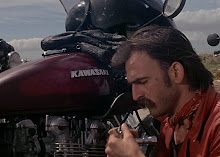I'm just going to come out and say it: the Norton Commando is my favorite motorcycle.
I like all of the different variants of the Commando sold from 1967 until 1977. I like the Hi-Rider chopper wannabe, the Fastback, the Street Scrambler and the Interstate.
My favorite variant is the Roadster, however. It just looks so perfect. It has a small 2.5 gallon gas tank and nice low handlebars. When someone says motorcycle, I think Norton Commando Roadster.
The Roadster shares its 750 and 850 parallel twins with the other Commando variants. The twins had between 51 horsepower and 58 horsepower depending on the state of tune.
Also available was the 750 "Combat" engine with 65 horsepower and high-compression pistons that was pretty fierce.
As with everything from Britain at the time, it had problems, however. The Combat engine had an annoying habit of breaking its pistons and wiping out the main bearings.
The real party-piece of the Commando was its Isolastic frame.
Because a parallel twin engine is basically two single cylinder engines placed next to each other, they are relatively cheap and easy to produce. The problem with the design is vibration. Not an annoying buzz like a power tool but a full on, make-your-arms-go-numb vibration. As you increase the displacement of the twin, the vibration gets worse. Various British manufacturers had to deal with things like broken headlight bulbs and cracked frames due to vibration.
If you've ever seen an old British bike sitting at a stop, you can actually watch the bike move along the ground as it vibrates. When Norton debuted their 750 twin in the Atlas the vibration was appalling.
For the Commando, Norton devised a primitive rubber mounting system for the drivetrain. The engine, transmission and swing arm were "isolated" from the frame in rubber mountings. This meant the twin could vibrate to its heart's content and the rider could enjoy the motorcycle as well as being able to feel his arms.
As with everything from Britain at the time, it had problems, however. As the swing arm (the rear suspension) was mounted in rubber, keeping the system in the proper adjustment is paramount. Too little free-play and the vibration would be back. Too much, and the handling would get very interesting as the swing arm would slide back and forth.
By now you're probably looking at the post title and wondering why I'm talking about an old Norton. Well here's the reason: Norton is back!
Norton was not exempt from the British motorcycle collapse of the 70's and closed its doors in 1977. In the subsequent years, several owners with big dreams and deep pockets have tried to resurrect Norton and failed.
There were some Norton models built in the 80's with Wankel rotary engines but they were expensive and unreliable. An American company called Vintage Rebuilds began producing an 880 Commando based on old Commandos with bored-out engines and modern components in 1995.
Vintage Rebuilds debuted a 961SS Commando with a host of high-tech parts in 2000 but had to shut down operations in 2006 due to money problems. Stuart Garner, an English businessman, has secured the rights to Norton and for the foreseeable future, the company has some security.
I'm not sure how to feel about the 961 Commando, though. It kind of looks like an old Commando, much the same way my new Bonneville looks like an old Bonneville. But then, it really doesn't.
The new Commando has some high-tech stuff like adjustable suspension, big Brembo brakes, a 5-speed gearbox and a whole bunch of carbon fiber bits. But then it also has a full steel frame and a dry-sump, pushrod parallel twin with 80 horsepower. That's not very high-tech.
It really looks like the new Commando was designed by a committee where one half wanted to make a sportbike and the other half wanted to make a retro bike. It looks like in the end they said "screw it, we'll make it both".
It just looks odd.
Oh, yeah, price. You may want to turn away. The base 961 Commando Sport starts at $18,839 and the top-of-the-line 961 Commando SE goes for an eye watering $25,121. Those prices are converted from Great British Pounds to U.S. Dollars.
What?! I'm sorry but those prices are ridiculous.
The Ducati 1198 superbike has adjustable suspension, carbon fiber stuff, Brembo brakes and 170 horsepower for $16,495. Ducati's GT1000 lacks the adjustable suspension and carbon fiber but has Brembo brakes and 92 horsepower for $11,495. Triumph's Thruxton 900 has adjustable suspension and 68 horsepower for $8,799.
If Norton wants to be anything other than an extremely niche brand, it has to have more reasonable pricing. One of the reasons Triumph was able to succeed when it was resurrected in the early 90's was their well designed, up-to-date and affordable products.
It's hard to try and figure out who the new Commando is being marketed to. It doesn't have the speed for the sportbike crowd but it's not retro enough for the retro crowd.
Maybe my opinion is skewed because I love the original Commando so much but I'm not impressed by the new Commando.
An expensive niche product in hard economic times is not a sound business model nor is it a recipe for sustained success. You may sell a few to rich guys with nothing better to spend their money on but what do you do when you run out of rich guys?
Triumph and Ducati have released modernized retro bikes with similar power and equipment for thousands less. It just doesn't make sense.
I'd love to see Norton come back and follow Triumph's model for success but it won't happen until they move out of the niche market and into reality.
Perfection defined: a 1973 Norton Commando Roadster 750...
And then oddity defined: the new 961 Commando.












